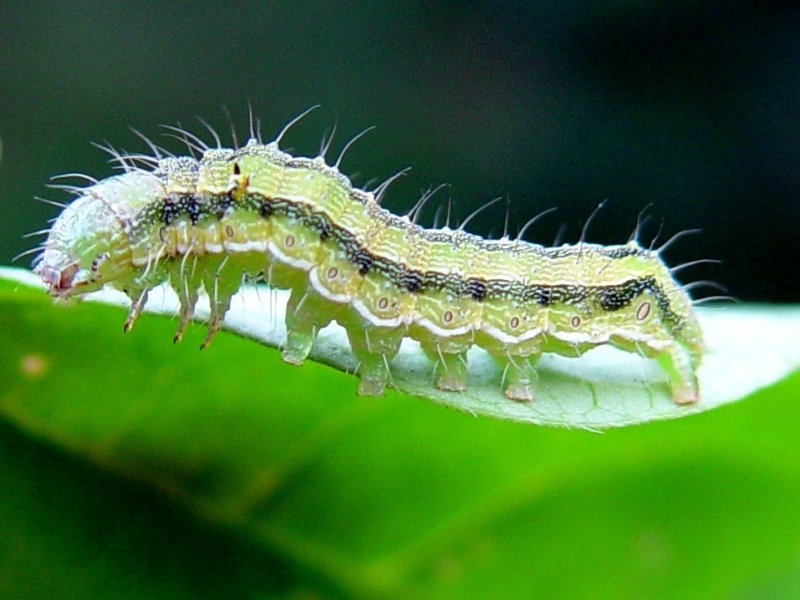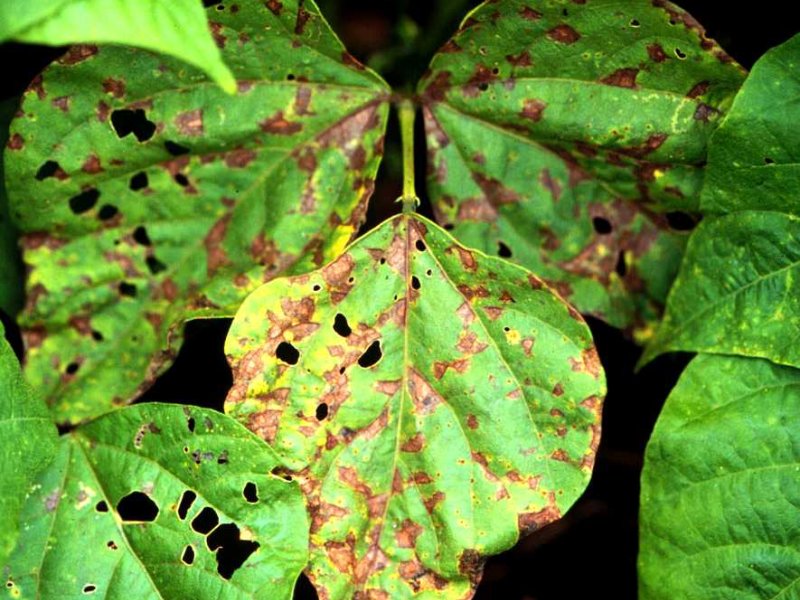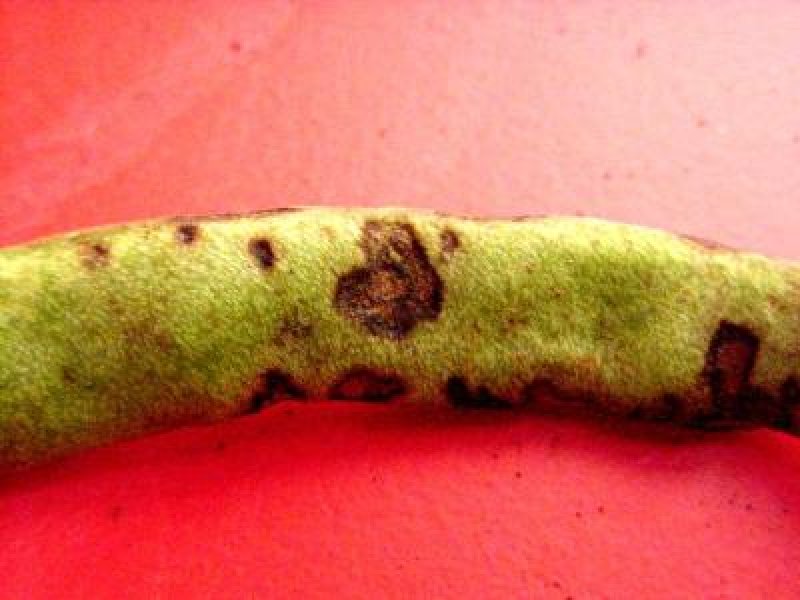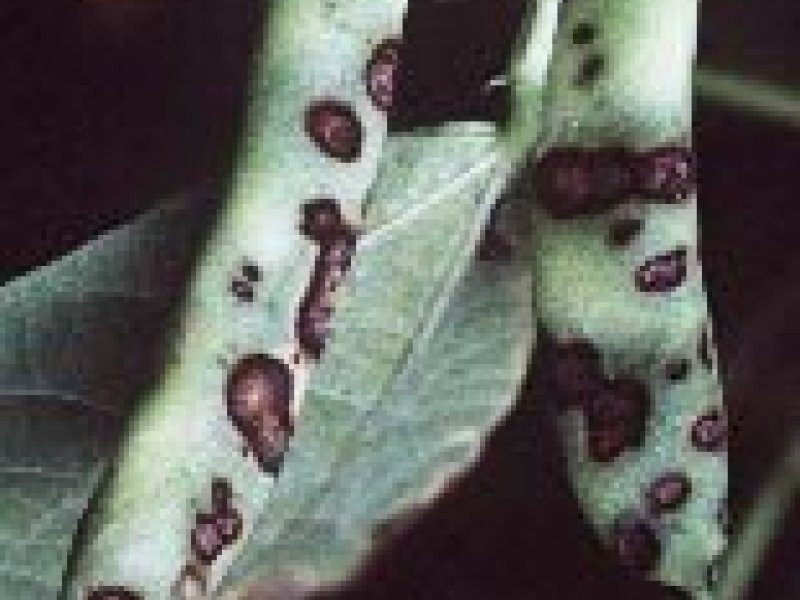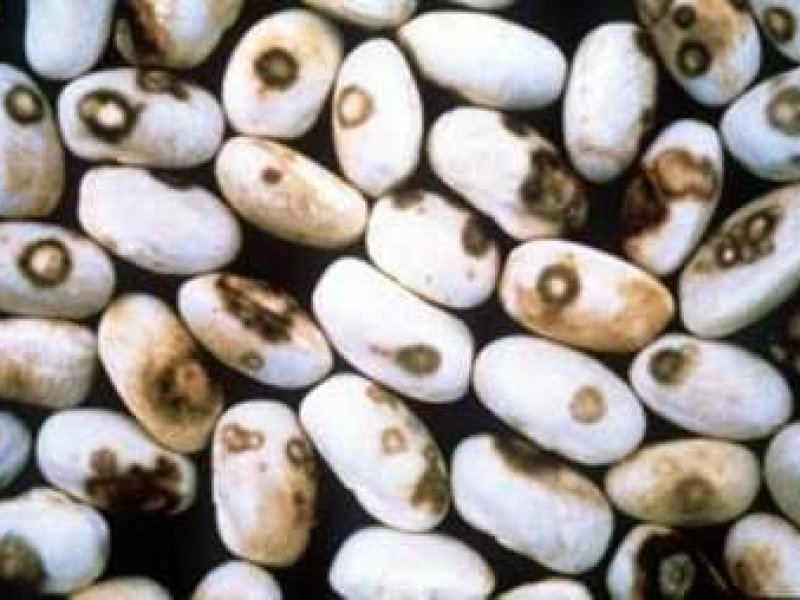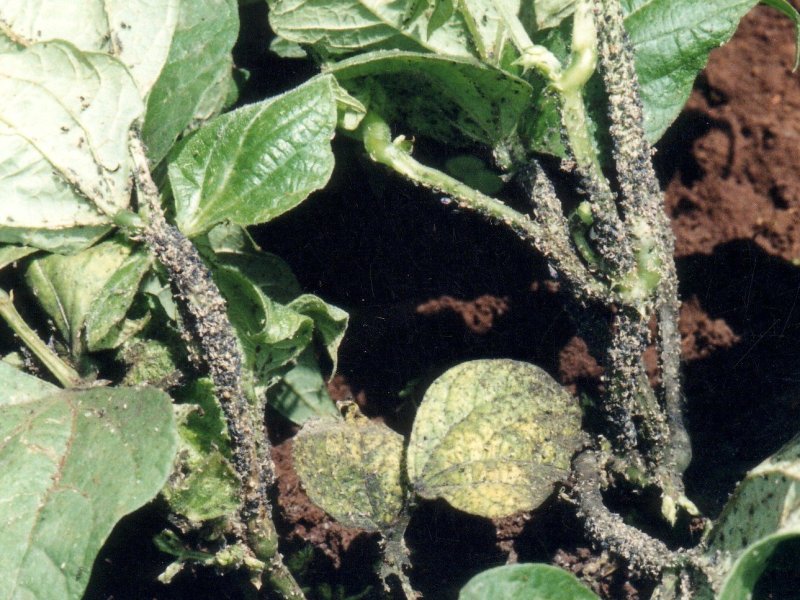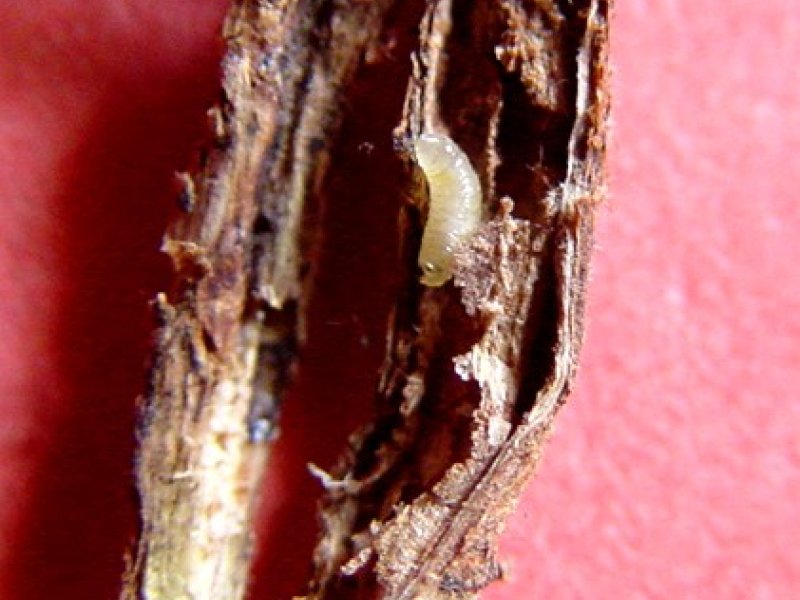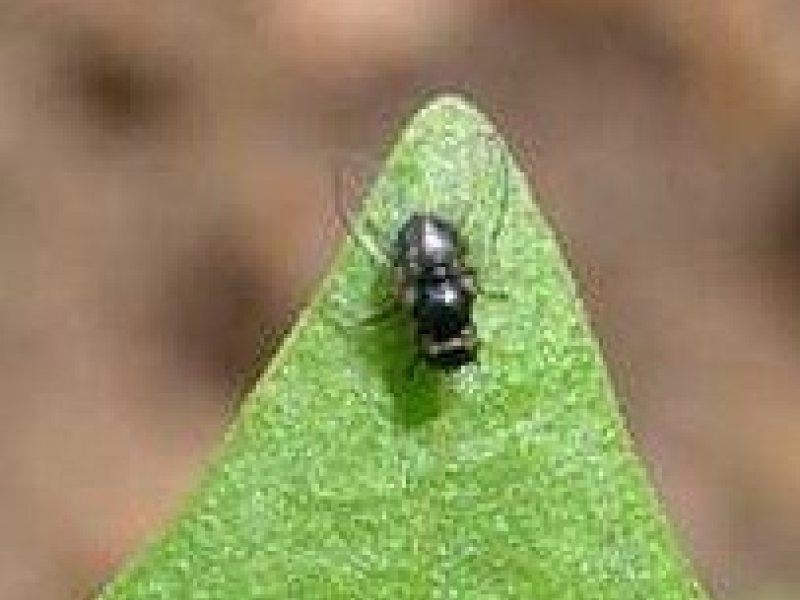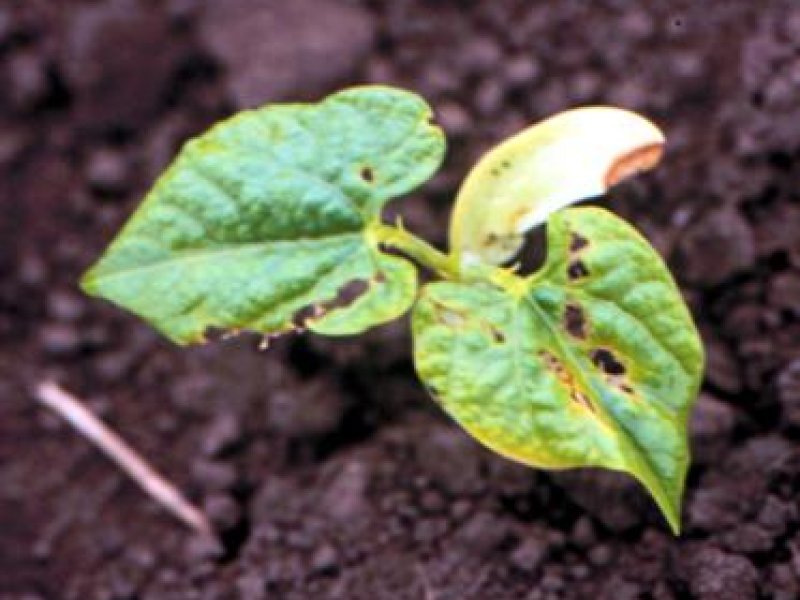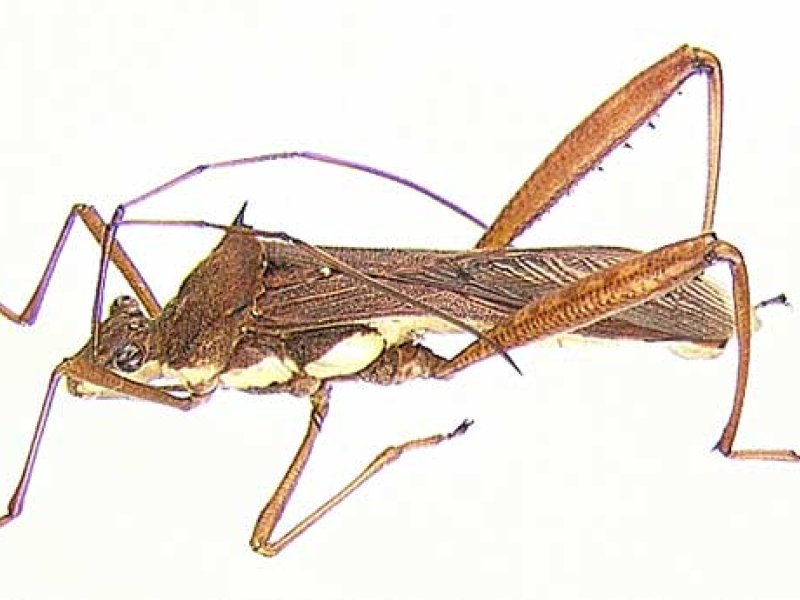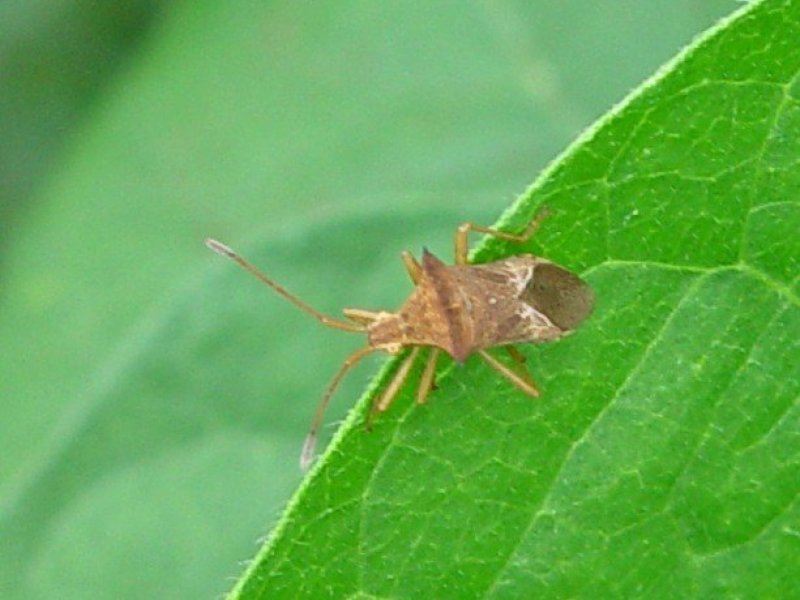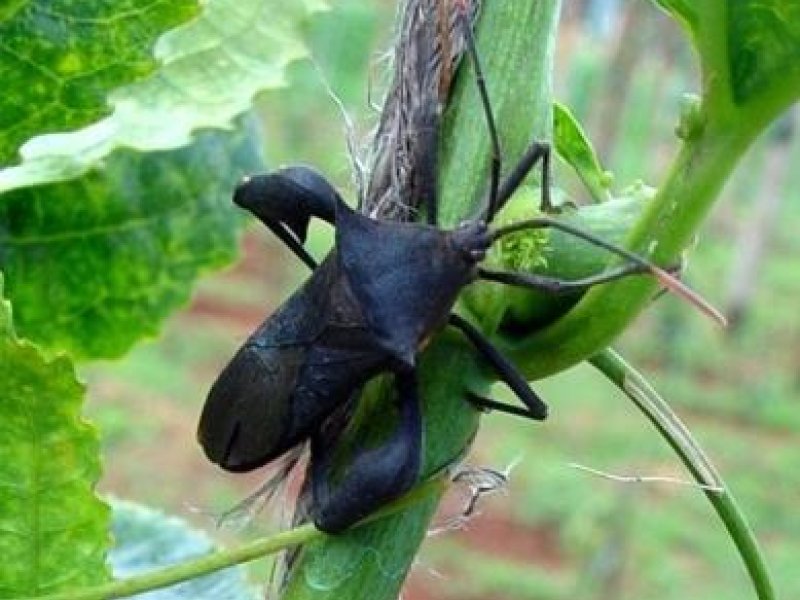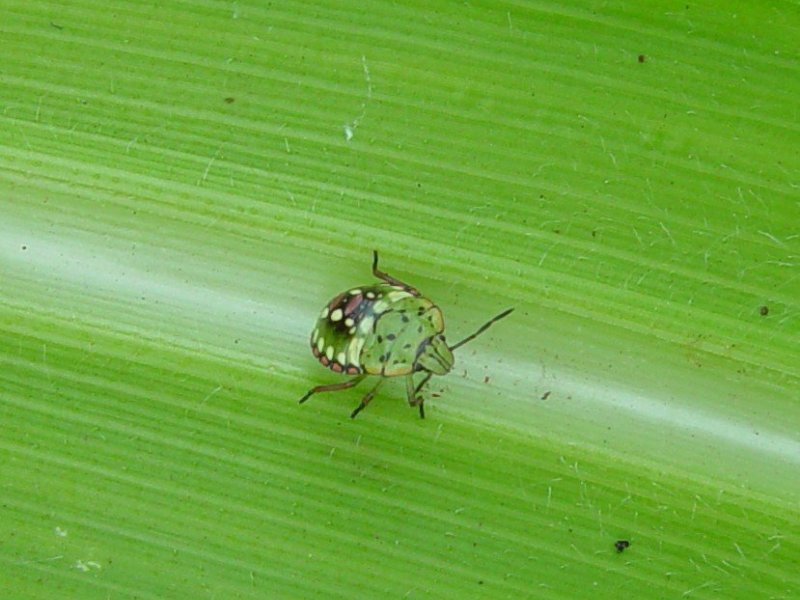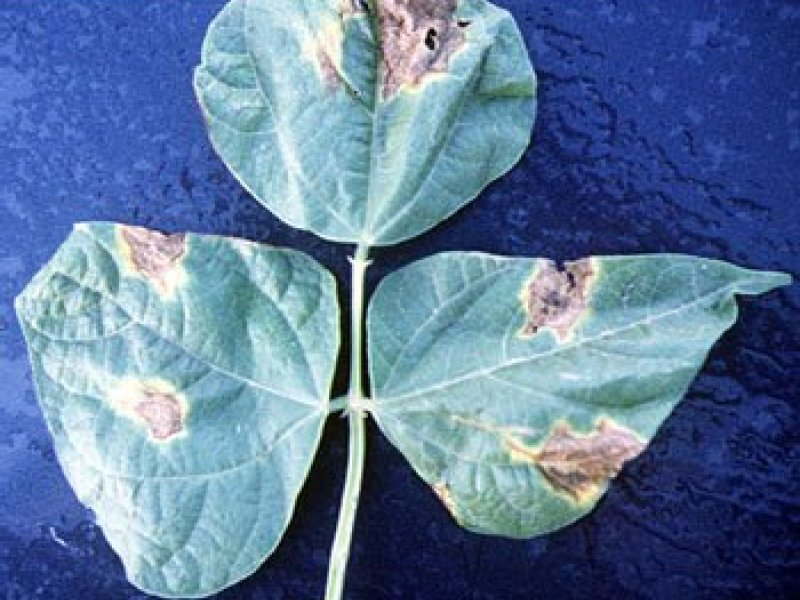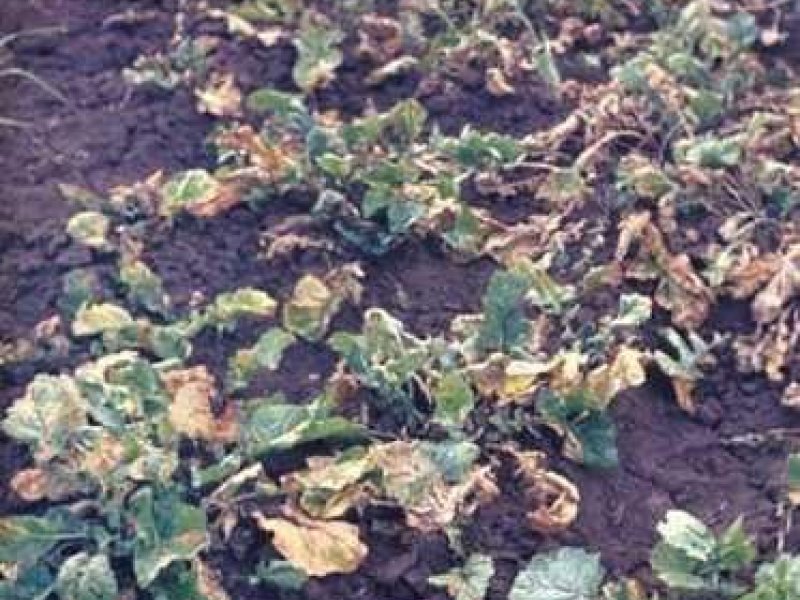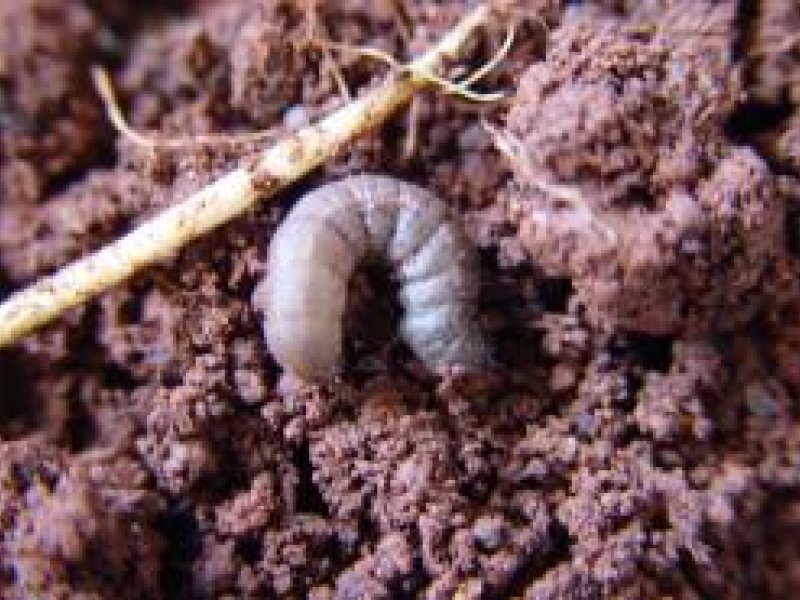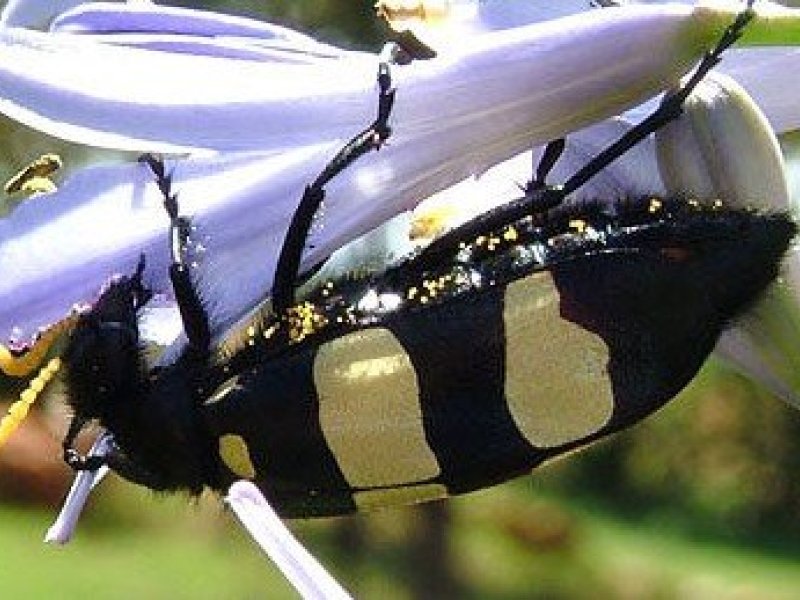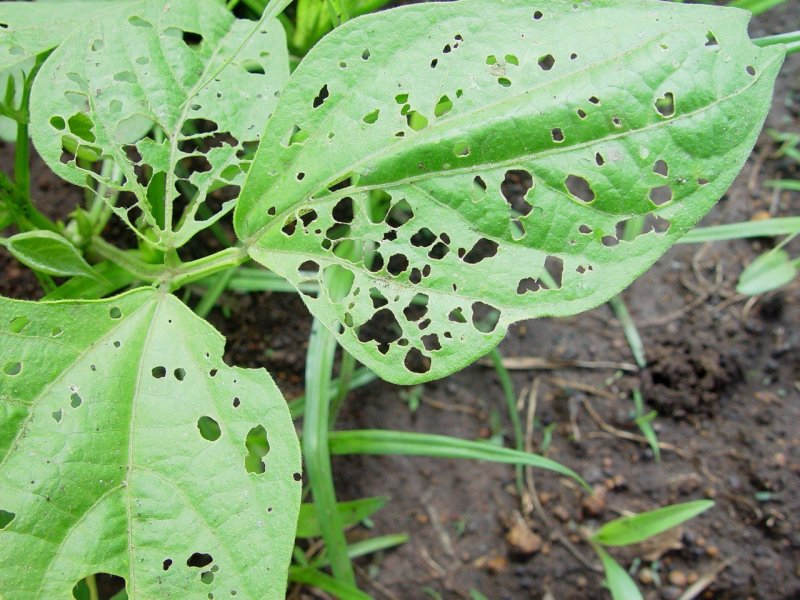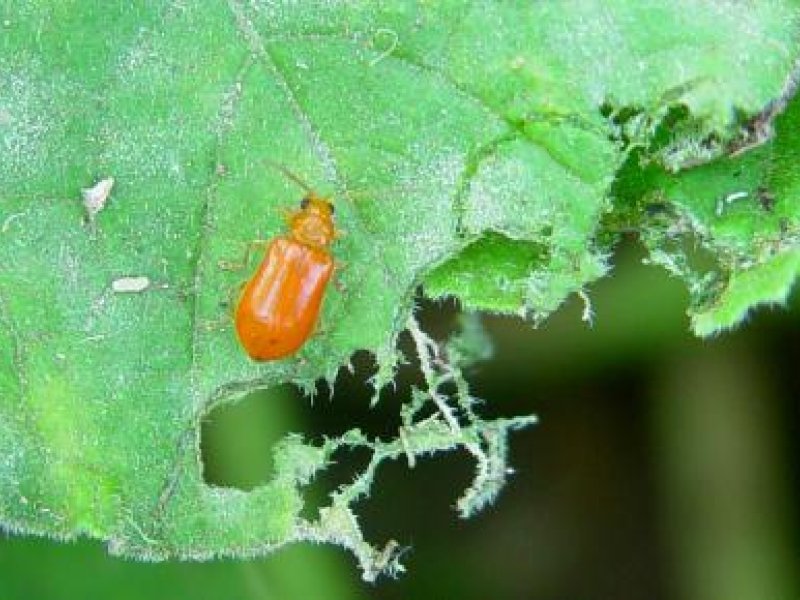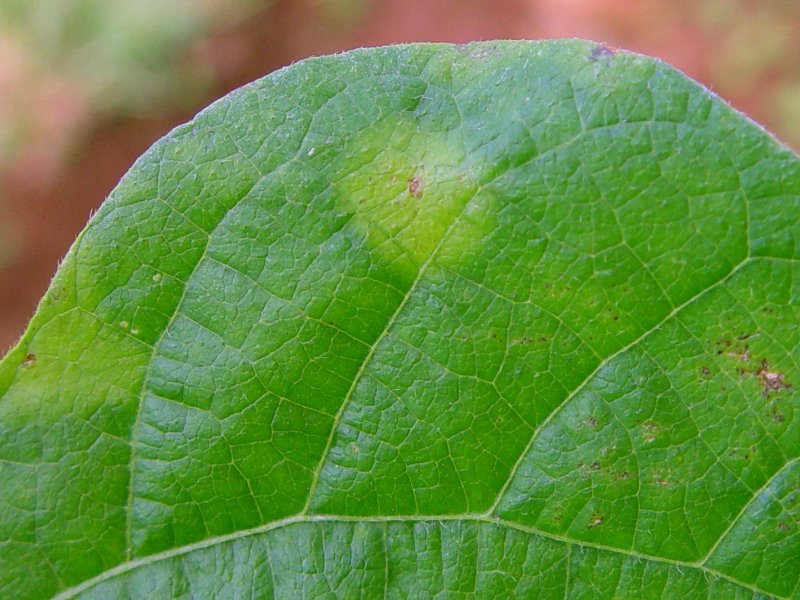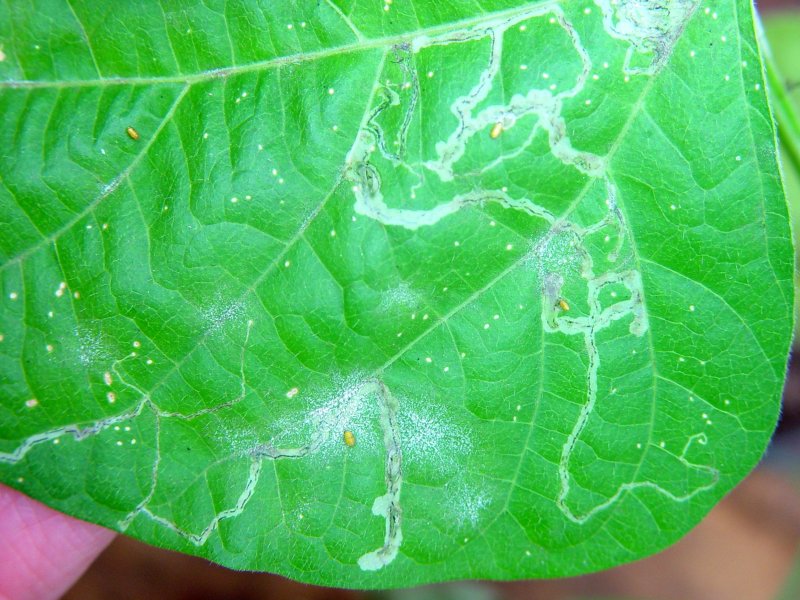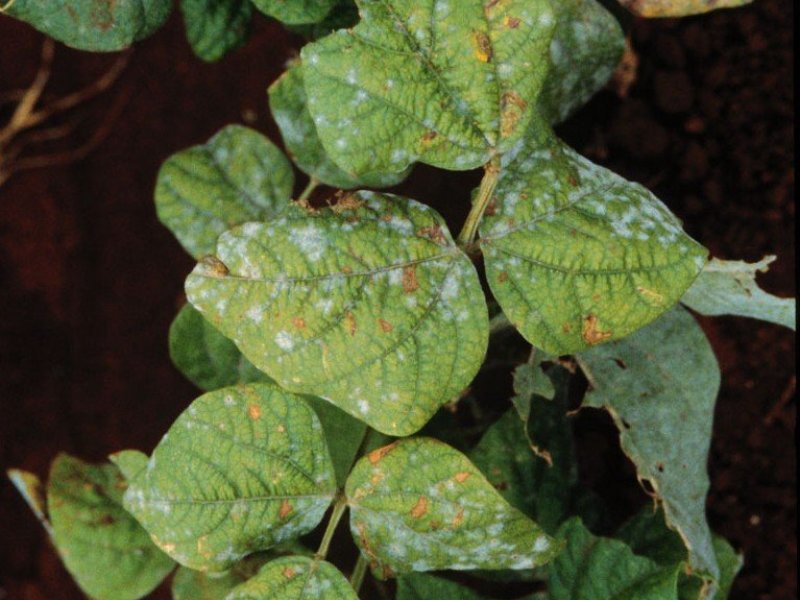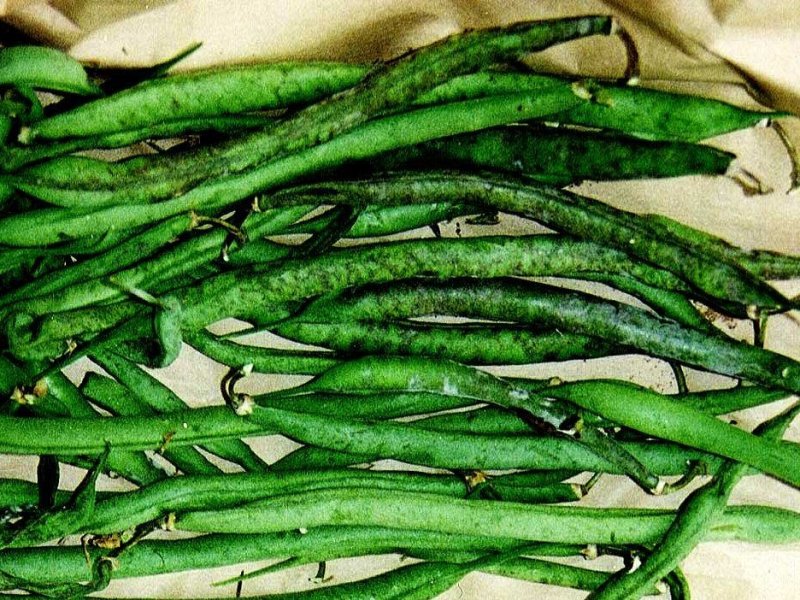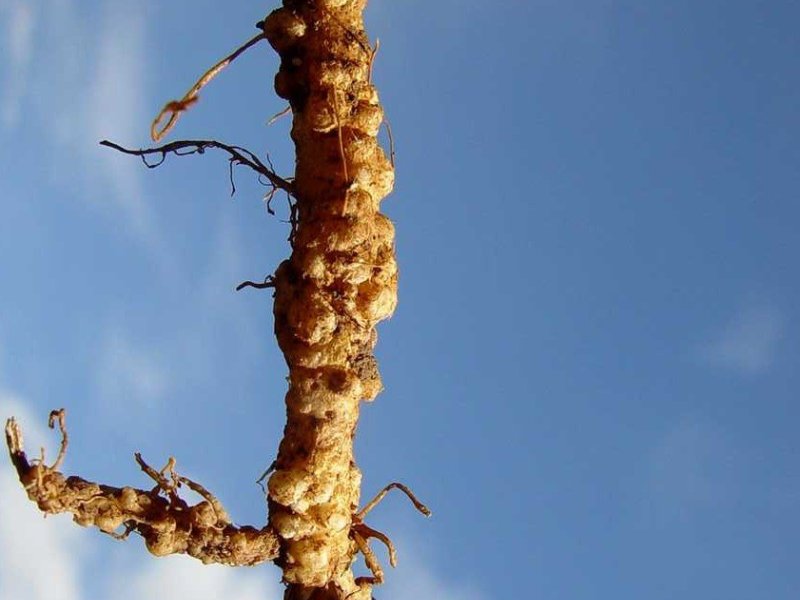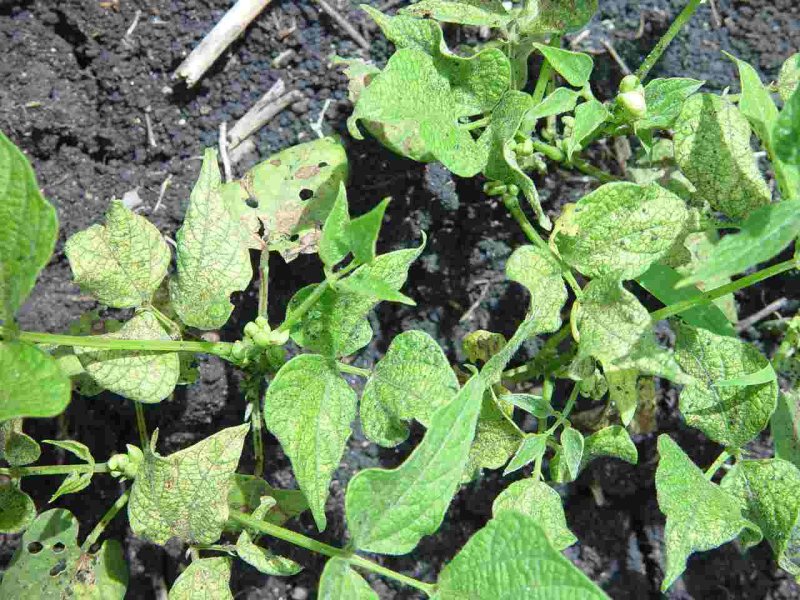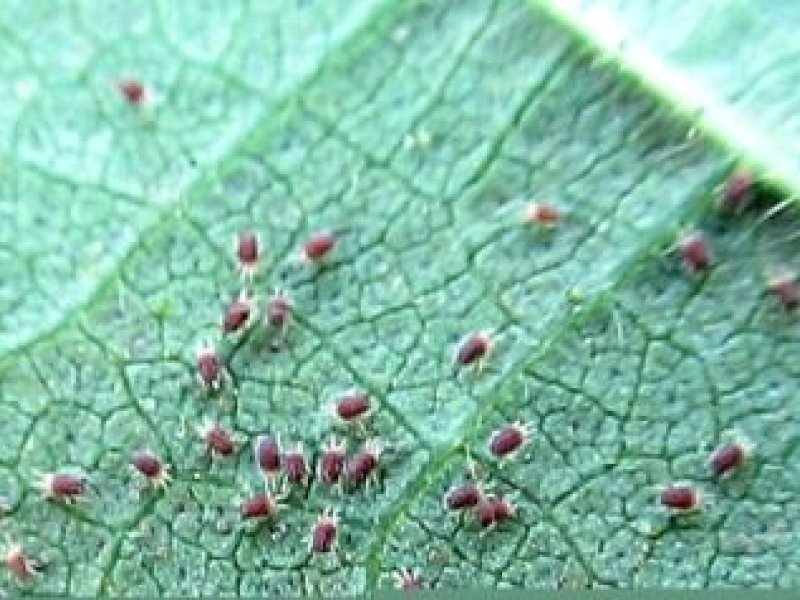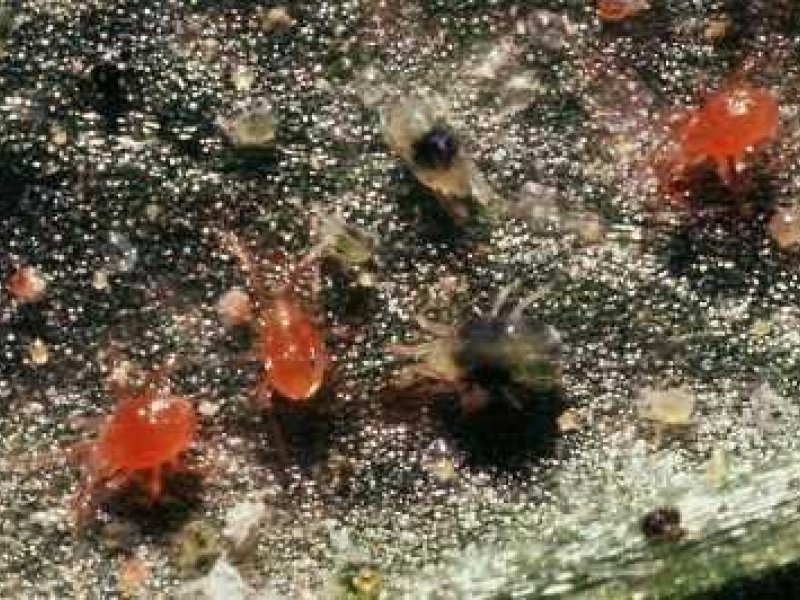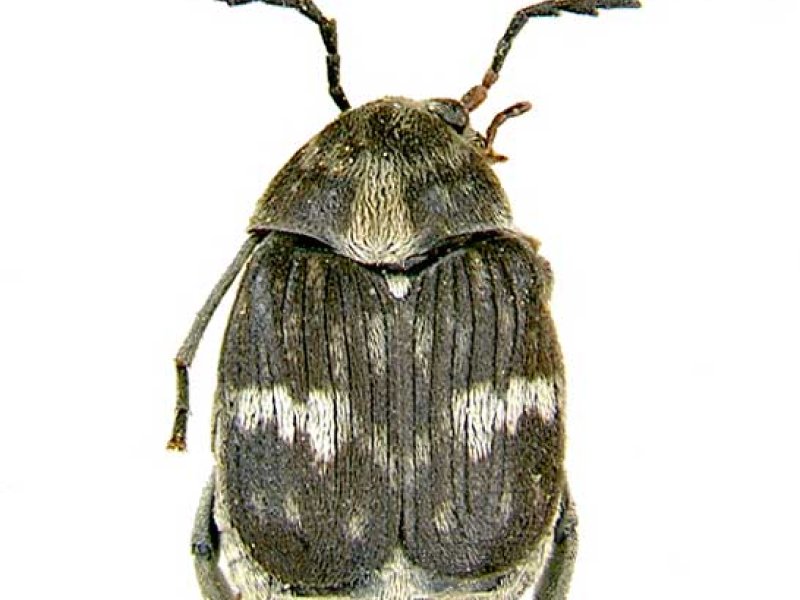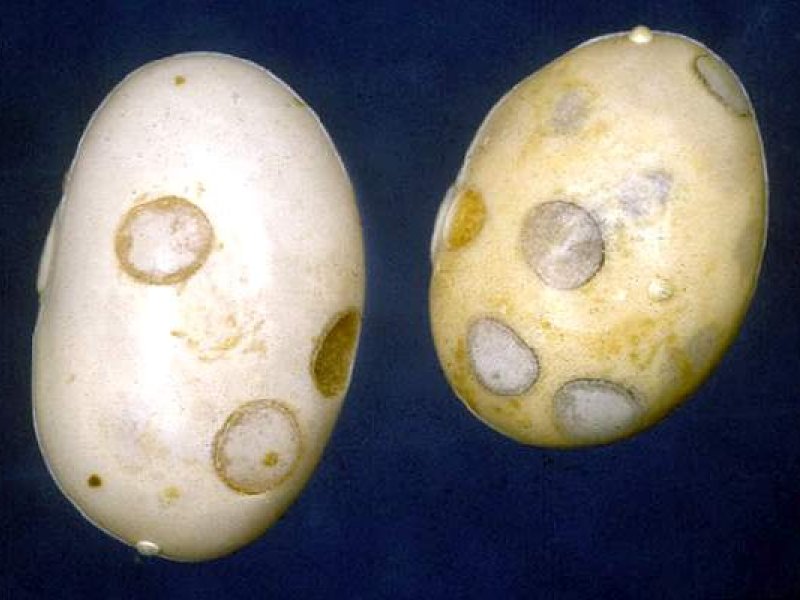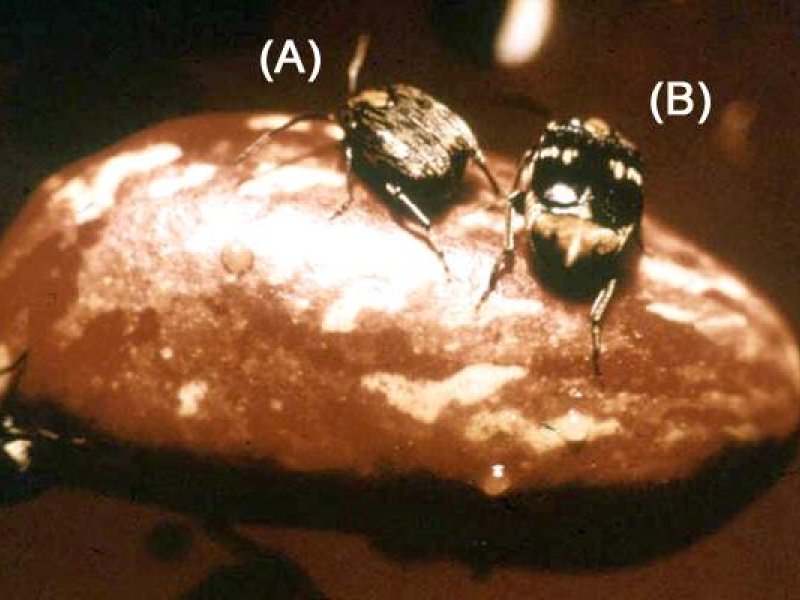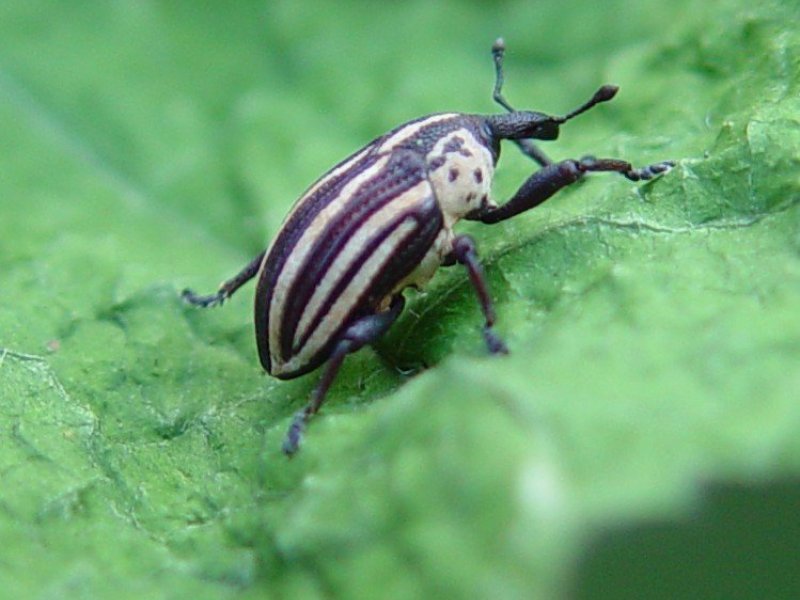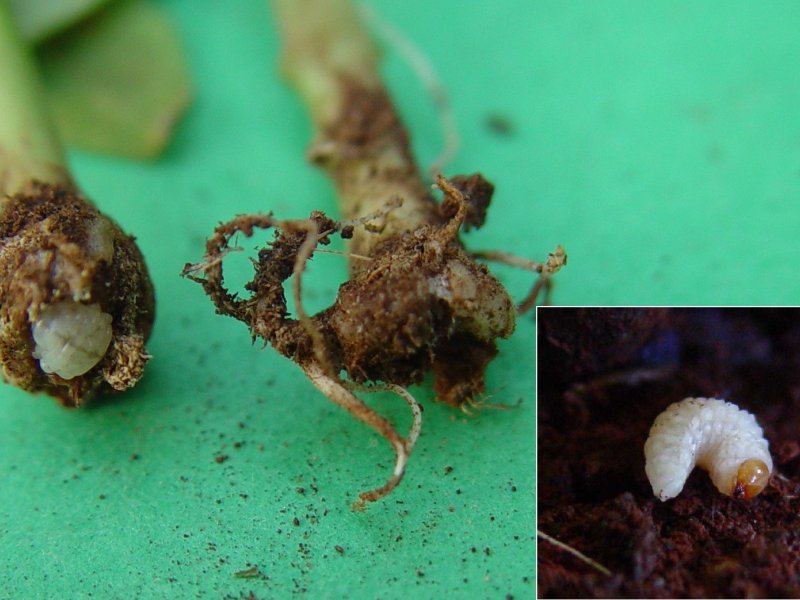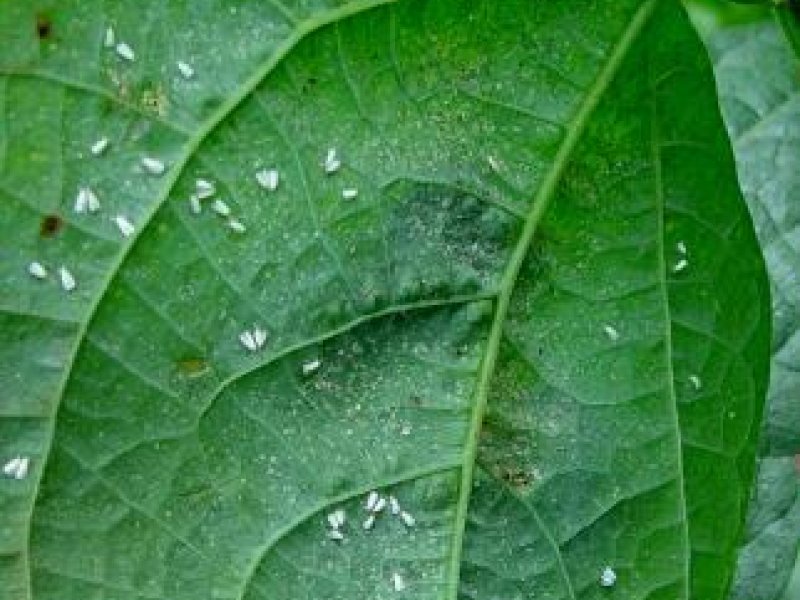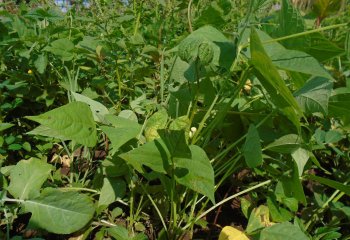|
African bollworm and other pod borers Several caterpillars are important pests as pod borers in common beans and French beans. The most common are the African bollworm (Helicoverpa armigera) and the legume pod borer (Maruca testulalis). They feed on leaves, flowers, pods and seeds. The African bollworm caterpillars are 3 to 4 cm long. They make clean circular holes in the pods. One caterpillar may damage several pods. Caterpillars of the legume pod borer attack pods at the point of contact with other pods, leaves or the stem. They frequently web together flowers, pods and leaves with excrements. Pod borers usually do not cause significant yield reduction in beans. However, they are quarantine pests, and are particularly important in French beans grown for export. If only 1 caterpillar is found in a consignment sent to Europe, the whole consignment may be rejected. If pod borers are found in a field, the beans harvested should be sorted very thoroughly to remove the bollworms manually. |
|
|
What to do:
|
|
Angular leaf spot (Phaeoisariopsis griseola) Symptoms consist of small dark brown spots with angular edges and are often numerous to give the foliage a checker-board appearance. The spots may increase in size, join together, and cause yellowing and necrosis of the affected leaves. This may lead to premature defoliation. When humid, the fungus produces a grey mould on the lower surface of the spots. Infected pods have brown blotches. The disease is favoured by high moisture and moderate temperatures (20-25°C). The disease is seed-borne. |
|
|
What to do:
|
|
Anthracnose (Colletotrichum lindemuthianum) Symptoms of anthracnose can appear on any plant part. Pale brown sunken spots may appear on the cotyledons of infected seedlings. Water may spread the disease to the hypocotyl, which if girdled, kills the seedling. Lesions on leaves are dark brown. They are restricted to the veins on lower leaf surface. On stems, lesions are elongated and sunken. On the pods, the fungus produces black, sunken lesions. These lesions penetrate deep into the pods and may cause shrivelling of the young pods. Infected seed become discoloured changing to yellow through brown to black. In damp weather, the centres of anthracnose lesions become covered with a pink spore mass. The disease is seed-borne. |
|
|
What to do:
|
|
Aphids (Aphis fabae) and (Aphis craccivora) The black bean aphid (Aphis fabae) and the black legume aphid (Aphis craccivora) are black to dark brown brownish in colour and winged or wingless and vary in size from 1.5 to 3.0 mm. Aphids feed by sucking plant sap. Small aphid populations may be relatively harmless, but heavily infested plants usually have wrinkled leaves, stunted growth and deformed pods. Plants, in particular young plants, may dry out and die under heavy aphid attack. Heavy attack on older plants may cause crop loss by decreasing flower and pod production. Damage may also reduce seed viability.
In addition, plants may become contaminated by honeydew produced by aphids and sooty mould growing on honeydew. French beans contaminated with honeydew and / or sooty moulds are not marketable. Aphids are also vectors of diseases, including the bean common mosaic virus. The black bean aphid is a widely distributed pest of beans. The black legume aphid usually attacks beans grown at low altitudes. |
|
|
What to do:
|
|
Bean common mosaic virus Symptoms of bean common mosaic virus (BCMV) are cupping and twisting of leaves with a light and dark green mosaic pattern. The dark green tissue is often bubbled and/or in bands next to the veins. Affected plants produce smaller, curled pods with a greasy appearance, and yields are reduced. The virus is seed borne. It can be transmitted by several aphid species. |
|
|
What to do:
|
|
Bean flies (Ophiomyia spp.) Bean flies also called bean stem maggots are serious pests in Africa. The adult is a tiny (about 2mm long) fly, shiny black-bluish in colour. The female fly pierces the young leaves to lay eggs and sucks the exuding sap. This leaves yellow blotches on the leaves, which are the first signs of bean fly attack and may serve as early symptom useful for monitoring the presence of this pest in the field. Maggots mine their way from the leaves down to the base of the stem, where they complete their development.
Maggot feeding destroys the tissue causing the stem to swell and split and reducing formation of lateral roots. Attacked plants produce adventitious roots in compensation. Maggots (yellow in colour) and pupae (brown or black in colour) can often be seen through the stem splits. Young seedlings and plants under stress wilt and die when attacked by bean flies. Older or vigorous plants may tolerate bean fly attack, but their growth will be stunted and their yield reduced. Damage is more severe in plants growing under poor conditions such as infertile soils and drought. |
|
|
What to do:
|
|
Bean rust (Uromyces appendiculatus var. appendiculatus) Rust spots (pustules) appear on all parts above the ground. They are most numerous on leaves, particularly on the underside. They are less abundant on stems and occur sparingly on pods. Initial symptoms are minute, slightly raised yellow pustules, which later become distinct circles, reddish brown in colour and surrounded by a yellow halo. The disease is spread long distance by wind. Plant to plant spread of the disease is by farm tools, insects or water splash. Severely infected leaves drop off. |
|
|
What to do:
|
|
Bean seed fly (Delia platura) The bean seed fly, also known as seed corn maggot, resembles small houseflies. It is about 1cm long. Female flies are attracted to recently disturbed open soil, where they lay eggs, especially where there are plant residues or when large amount of manure has been applied. The maggots bore into germinating bean seeds or the cotyledons (first seed leaves) of the young plant eating them. This causes patchy emergence of seedlings. If damaged plants emerge, they are stunted, weak and fail to develop into productive plants. Pupation takes place in the soil, 2-4 cm under the soil surface. |
|
|
What to do:
|
|
Bugs Several species of bugs feed on beans. The most common in East Africa are the spiny brown bug (Clavigralla tomentosicolis), Riptortus bugs (Riptortus dentipes), the green stink bug(Nezara viridula) and the tip wilter (Anoplocnemis curvipes). Bugs suck on pods causing tiny lesions, and may cause shrivelling and rotting of the seeds, which lose viability. The whole pod may also shrivel. French bean pods showing signs of bug attack (pimples) are not marketable. Tip wilters sometimes suck the sap on shoots, causing them to wilt and turn necrotic and rot. The green stinkbug transmits a fungus to developing seeds, causing yeast spot, which is a widespread but a minor disease of beans in Africa. Bugs are difficult to control since they usually feed on a wide range of crops and are very mobile. |
|
|
What to do:
|
|
Common blight (Xanthomonas axonopodis pv. phaseoli) This disease is a constraint to bean production in Kenya. Crop losses of between 10 and 75% have been reported. The common blight produces similar symptoms on leaves, pods, stems and seeds. Small water-soaked spots are the first symptoms observed on leaves and appear within 4 to 10 days of infection. As the spots develop, the centre becomes dry and brown. The lesion is surrounded by a narrow band of bright yellow tissue. However, yellowed tissue is occasionally absent. |
|
|
What to do:
|
|
Cutworms Cutworms attack young seedlings. First instars are 0.7-1 cm, later instars are 3.5-5cm long. The caterpillar emerges from the soil at night, encircles the plant with its body and cut through the stem of young plants just above ground level. They may also damage the plants underground. Cutworm damage causes plants to wilt and die. Cutworm damage is usually minor and does not normally warrant control. However, in severe outbreaks a young crop may be destroyed. |
|
|
What to do:
|
|
Flower or blister beetles (Mylabris oculata) The adults of the flower beetles, also known as blister beetles, feed on bean flowers (petals and / or pollen) reducing pod set. The adults are medium to large sized beetles (2-5 cm in length), usually black and yellow or black and red in colour. The immature stages (larvae) do not feed on plants. They live in the soil and eat grasshopper eggs. |
|
|
What to do:
|
|
Foliage beetles (Ootheca spp.; Monolepta spp.) In East Africa foliage beetles (Ootheca spp.; Monolepta spp.) are commonly found feeding on bean leaves. Foliage beetles chew small round holes in the leaves. They are about 4-7mm long. They may be a serious problem when present in large numbers or when attacking young plants. Heavy attacks may cause defoliation. Attack on young plants may reduce plant vigour, plant size and yield. The problem is more acute in fields with continuous growing of beans.
Ootheca beetles are normally not serious pest of French beans, but are an important pest of common beans in East Africa. The larvae (grubs) of foliage beetles live in the soil feeding on roots. Their feeding may cause stunted growth and premature ageing of the plants.
Grubs of weevils live in the soil feeding on roots or may bore into the stem of the bean plant causing swellings or galls, as is the case of the striped bean weevil. Plants attacked by grubs of this weevil show stunted growth and may die. The stem of the plant breaks easily during harvesting (see more below). |
|
|
What to do:
|
|
Fusarium root rot (Fusarium solani f. sp. phaseoli) Seedlings infected with Fusarium root rot appear dwarfed. The primary leaves are often yellow, later turning necrotic and finally the seedlings wilt. Fusarium species infect bean roots when the soil is too wet, or too hot for good bean growth. The fungus survives in soil for long period.
|
|
|
What to do:
|
|
Halo blight (Pseudomonas syringae pv. phaseolicola) The most characteristic halo blight symptoms occur on bean foliage. Initially, small water-soaked spots resembling pin pricks appear on the lower leaf surface. These spots turn brown in a few days, and the surrounding tissue gradually become yellow-green. This zone of yellowed tissue around the spot resembles a halo, hence the name of the disease. Pod lesions first appear as small water-soaked pin pricks on the pod surface. These lesions gradually enlarge to form dark sunken spots of various sizes. A whitish bacterial ooze appears on the spots when wet. Halos do not develop around pod lesions. Pod lesions are especially important to the French bean industry because they make the bean pod unacceptable to fresh market and processors. On dry beans, pod lesions are of less importance because the beans are shelled before marketing. When infected seed is used, the primary leaves of seedlings show interveinal chlorosis, suggestive of mosaic virus infection. |
|
|
What to do:
|
|
Leafhoppers (Empoasca dolichi and E. lybica) They are widely distributed in Africa. Leafhoppers are small (about 2.5 mm long), slender mobile insects and green in colour. They move sideways when disturbed. Numerous leafhoppers may be seen on the underside of leaves. Their feeding on beans causes down curled leaves with yellowish margins. Eventually the whole plant may turn yellowish brown and dry-up. In Africa, leafhopper damage is usually minor and does not warrant control. |
|
|
What to do:
|
|
Leafmining flies (Lyriomiza spp) Leafminers are small flies, about 1.5 mm in length. The maggot makes long, slender, white mines (tunnels) in leaves.
Severely mined leaves may turn yellow and drop. Severely attacked seedlings are stunted and may eventually die. Control measures are necessary when attack is severe, especially on young plants. |
|
|
What to do:
|
|
Powdery mildew (Erysiphe polygoni) A white powdery mould appears on the upper leaf surfaces. Severely diseased leaves turn yellow and die. Leaf petioles, stems and pods can also be affected. |
|
|
What to do:
|
|
Root-knot nematode (Meloidogyne incognita, M. javanica) They cause stunting and yellowing of plants with a tendency to wilt in hot weather. If infested plants are pulled out from the soil, the roots can be seen to be distorted, swollen and bearing knots of various sizes. Infested roots under severe infestation decay.
These knots should not be confused with legume nodules, which are normally small and round, and are attached to the outside of the roots, whereas swellings of root-knot nematodes are within the body of the root. When active nodules are sliced, they are pinkish in colour. |
|
|
What to do:
|
|
Spider mites (Tetranychus spp.) Spider mites feeding on bean plants may cause reduction in plant growth, flowering, number and length of pods, and number of seeds per pod. Damage is most severe when mites attack young plants. Mite damage may be particularly severe during the dry season. |
|
|
What to do:
|
|
Storage pests: Bruchids (Zabrotes subfasciatus, Acanthoscelides obtectus) Bruchids such as the bean bruchid or dry bean weevil (Acanthoscelides obtectus), and the Mexican bean weevil (Zabrotes subfasciatus) are storage pests, attacking dried beans in Africa. They are small beetles (3-5 mm) grey, brown to reddish-brown in colour. Females of the dry bean weevil lay eggs glued to the bean seeds, while females of the Mexican bean weevil lay eggs scattered between the bean seeds. Development takes place inside the bean and takes about one month before the adult emerges. The larvae feed on the seeds destroying them or reducing germination capacity. The adult emerges from the seeds leaving small round holes on the bean seeds. Heavy infestation can result in a large number of holed seeds, with adults moving across the stored beans. The dry bean weevil can attack pods in the field laying eggs on ripening pods. The Mexican bean weevil attacks only beans in storage. |
|
|
What to do:
|
|
Striped bean weevil (Alcidodes leucogrammus) Several species of snout weevils are commonly found feeding on bean leaves. Adult weevils chew the edges of the leaves cutting circular discs. Grubs of weevils live in the soil feeding on roots or may bore into the stem of the bean plant causing swellings or galls, as is the case of the striped bean weevil.
The adult of the striped bean weevil is 10-15mm long, dark brown in colour with whitish to yellowish longitudinal stripes. The females lay eggs in the soil near bean plants. Emerging grubs bore and feed inside the stem, causing cankerous swelling or galls. Fully-grown grubs are white, about 10mm long, have no less and are C-shaped. Pupation occurs in an earthen cell attached to the plant. Plants attacked by grubs of this weevil show stunted growth, lodging, and eventually may die. The stem of the plant breaks easily during harvesting. In Kenya, striped bean weevil only occurs occasionally, and to a minor extent and control measures are usually not required.
Beetles can be collected manually and destroyed. Plants damaged by the grubs can be removed and the grubs destroyed. |
|
|
What to do:
|
|
Whiteflies (Bemisia tabaci and Trialeurodes vaporariorum) Whiteflies are important pests of beans. Both the larvae and the adults pierce and suck the sap from leaves, which may cause reduced plant growth, yellowing of leaves, and wilting of the plant when present in large numbers. They produce honeydew, which may lead to growth of sooty mould on leaves and pods. Heavy growth of sooty mould reduces photosynthesis affecting plant growth. French bean pods contaminated with sooty mould are unmarketable. Control measures on beans are justified if large whitefly numbers attack the plants during the early stages of the crop. Whitefly infestations after the onset of flowering usually do not affect yield. Adults are small (1-3 mm long), with two pairs of wings that are held roof-like over the body. They resemble very small moths. |
|
|
What to do:
|
Geographical Distribution in Africa
Geographical distribution in Africa
Common bean - <i>Phaseolus vulgaris</i> was domesticated in Central and South America more than 6000 years ago.
It originated in the Americas and was domesticated in Mexico, Peru and Colombia 8000 years ago. Prior to Columbus it was unknown in the Old World, but later it has become an important crop in Europe and Africa. It is widely cultivated in many parts of the tropics and subtropics and throughout the temperate regions. Common bean is the most important pulse crop throughout tropical America and many parts of tropical Africa. It is of little importance in India and most of tropical Asia, where indigenous pulses are preferred.
Native to:
Costa Rica, Guatemala, Honduras, Mexico Central, Mexico Gulf, Mexico Northeast, Mexico Northwest, Mexico Southeast, Mexico Southwest, Nicaragua, Panamá
Introduced into:
Africa; Algeria, Angola, Benin, Botswana, Burundi, Cabo Verde, Chad, Cote de Ivore, Democratic republic of Congo, Djibouti, Egypt, Eritrea, Ethiopia, Ghana, Kenya, Lesotho, Libya, Madagascar, Malawi, Mali, Mauritania, Morocco, Niger, Republic of South Africa, Republic of the Congo, Rwanda, S. Sudan, Senegal, Somalia, Sudan, Swaziland, Tanzania, Togo, Tunisia, Uganda, Zimbabwe,Guinea, West Siberia
(Phaseolus Vulgaris L. | Plants of the World Online | Kew Science, n.d.)
Read more
North Africa: Oubya (Morocco) (Chaachouay, N. et al., 2019)
Southern Africa: (Otchi) Poke (Umubumbu, Angola), Feijoeiro Ordinario (Portuguese, Angola), Makasikila (Kikongo, Angola) (Lautenschläger, T et al., 2018); E mbotyi (Isi Xhosa, S. Africa) (Maroyi, A., 2017).
Western Africa: Nii "Tèengu Soo" (Bandiagara, Mali) (Inngjerdingen, K.T et al., 2004); Sona (Tem, Togo) (Karou, S.D et al., 2011);
Eastern Africa: Majani ya Maharagwe (Swahili, Kenya), Nyeni cia maboco (Kikuyu, Kenya), Mboso (Kamba, Kenya); Zarikô (Antakarana, Madagascar), Tsaramaso (Malgache, Madagascar), Haricot (Fançais, Madagascar) (Nicolas, J. P., 2012); Khwanya (Bean leaves) (Yao, Malawi), Mbwanda (Yao, Malawi), Nyemba (Chiwewa, Malawi) (Maundu., 2006).; Chimpapila (Bean leaves) (Bemba, Zambia), Umukarankuba (Kinyarwanda, Rwanda) (Lestrade, A., 1955)
Central Africa: Haricot rouge (local French, Cameroon) (Mpondo, E. M et al., 2015); Cishimbo (shi, DRC) (Defour, G., 1994); Madeso manene (Kongo, DRC), Haricot vert (French, DRC Congo); Ariko (Mpongwè, Galoa, Nkomi, Orungu), Mariku (Eshira, Bavarama, Bavungu, Bapunu, Gabon), Butsangi (Baduma, Gabon), Usangé (Béséki, Gabon), Uhangé (Benga, Gabon), Bésangé (Bakélé, Gabon) (Raponda-Walker, A., & Sillans, R., 1961)
Introduction
The common bean, Phaseolus vulgaris, is a herbaceous annual plant in the family Fabaceae which is grown as a pulse and green vegetable. Beans are cultivated widely worldwide, forming one of the most significant food sources in Africa and Latin america. Beans were introduced to Africa from Latin America several centuries ago. To date beans are a vital staple in Africa, providing the main source of protein. Beans are consumed in many forms; the young leaves, green pods, and fresh bean grains are used as vegetables. Consumption of bean leaves is reported from the tropics from southern and eastern Africa: South Africa, Zimbabwe, Zambia, Malawi, Tanzania, Kenya and Uganda.
Pulse crop ; In tropical Africa common bean is primarily produced and consumed as a pulse. The mature dry seeds of common bean are eaten worldwide as a pulse and the immature pods and seeds as a vegetable. In tropical Africa the bean is most typically consumed boiled, often with seasoning and some oil added. It may also be mashed or made into soup. In many parts of the world the dry seeds of common bean are canned, either alone or in tomato sauce.
Leafy vegetable; Common bean leaves are eaten as a vegetable, e.g. during the hunger months of the year when not much food is available. Consumption of the bean leaves is more prevalent in the cooler highlands of east and southern Africa.
In South Africa, the leaves are commonly eaten as a cooked green called moroqo or m'fino. In the inland highveld, the bean leaves is dried in the sun to store for the dry season. Dried morogo is frequently available year-round, in urban as well as rural markets.
The Shona, Kaianga and Zezuru people of Zimbabwe eat Bean leaves as cooked greens regularly, with a peanut paste or stew when available. In Zambia, fresh bean leaves are cut up and boiled with salt or trona (crude sodium carbonate) and eaten immediately, or dried in the sun for two or three days. In Malawi bean leaves are harvested during the pod filling stage. The fresh leaves are sundried on mats and stored in sacks. Although young leaves are preferred, older leaves are also eaten, usually cooked with sodium carbonate, trona or potash to soften them. The Chewa and other peoples eat bean leaves with peanut paste or stew
In Uganda, bean leaves are commonly eaten fresh-cooked and are dried for dry season consumption. They are used to supplement the staple food dish as a sauce, a relish added to meat and fish, and mixed with the bean seed itself. In Kenya, bean leaves are important in the higher rainfall areas where most beans are grown. Intercropping is the standard practice, usually in rows between other crops, but sometimes in small patches. The leaves are steamed, boiled or fried alone or in combination with other vegetables, depending on use and availability.
Various local spices and trona may be used to alter the leaves' consistency. Most are eaten as an accompaniment to a high-carbohydrate food stuff such as maize, sorghum, cassava, banana, etc. However in Kenya, bean leaves are not an important market commodity, even at the local level, although some will be sold, particularly in drier areas or in periods of famine or shortage.(The Beannicowpea collaborative research support program (CRSP), n.d.)
Livestock fodder; Crop residues are often used as fodder.
General Information
The common bean is typically a climbing, trailing or erect and bushy annual herb,depending on the variety being grown. The leaves grow alternately on the stems, are green or purple in color and are divided into 3 oval leaflets with smooth edges. The leaves can grow 6–15 cm long and 3–11 cm wide. The common bean produces white, pink, lilac or purple flowers which are approximately 1 cm in diameter, and bean pods 8–20 cm long and 1–1.5 cm wide which can range in color from green to yellow or black to purple. Each pod contains 4-6 smooth, kidney-shaped beans. Common bean plants are annual plants and last only one growing season and range greatly in size from the bushy varieties 20–60 cm in height; to vines or runner beans which can reach 200 –300 cm in length. (Wortmann, C.S., 2006)
Common beans do well in regions with temperatures between 15 and 27°C. The crop can tolerate the maximum temperatures of about 29. 5°C. Temperatures close to or above 35°C, and stress due to moisture during the flowering stage and pod formation may cause abortion effects to several blossoms and under development of new pods. The sufficient conditions necessary for beans growing are; rainfall range between 350 and 500 mm and relatively low humidity. Low humidity and enough rainfall are significant in controlling the risks associated with bacterial and fungal diseases.
Common bean (dry bean) varieties in Kenya
|
Variety |
Optimal production altitude (m) |
Maturity period (months) |
Grain yield (t/ha) |
Remarks |
|||
|
"Canadian Wonder (GLP 24)" |
1200-1800 |
3.0 |
1.3-1.8 |
Seeds are shiny dark reddish purple, recommended for medium rainfall areas, resistant to angular leaf spot (ALS) and anthracnose but susceptible to common bean mosaic virus (CBMV) and rust |
|||
|
"KAT/B-1"
|
1000-1800 |
2.5 |
1.4-1.9 |
Seeds creamish-green, tolerant to ALS, common bacterial blight (CBB) and CBMV, tolerant to drought and heat and grows well under tree/banana shades |
|||
|
"KAT/B-9" |
900-1600 |
2.5-3.0 |
1.0-1.8 |
Seeds brilliant red, more drought tolerant than KAT/B-1, tolerant to CBMV and rust |
|||
|
"KAT X16" |
900-1600 |
2-3 |
1.5-1.8 |
|
|||
|
"KAT X56" |
900-1800 |
2.5-3.0 |
1.5-1.8 |
Seeds brilliant red, tolerant to CBMV, charcoal rot and rust |
|||
|
"KAT X69" |
1200-1800 |
2-3 |
1.5-1.8 |
Seeds red with cream flecks, resistant to CBMV and rust, tolerant to ALS and charcoal rot, susceptible to lodging |
|||
|
"Kenya Wonder" |
1000-2000 |
3.0-3.5 |
1.1-2.1 |
Moderately resistant to ALS, CBB, CBMV and halo blight (HB) |
|||
|
"Kenya Red Kidney"
|
1000-2100 |
2.5-3.0 |
1.1-2.8 |
Moderately resistant to ALS, CBB, CBMV and HB |
|||
|
"KK 8" |
1500-1800 |
2.5-3.0 |
1.8-2.0 |
Tolerant to root rot |
|||
|
"KK 15" |
1500-1800 |
2.5-3.0 |
1.8-2.0 |
Tolerant to root rot |
|||
|
"KK 22" |
1500-1800 |
2.5-3.0 |
1.8-2.0 |
Tolerant to root rot |
|||
|
"Miezi Mbili" |
1000-2000 |
2.5-3.0 |
1.2-2.3 |
Moderately resistant to ALS, anthracnose, CBB, CBMV and HB |
|||
|
"Mwezi Moja (GLP 1004)" Figure 2; Bean. Mwezi Moja (GLP 1004). Machakos.P Maundu |
1200-1600 |
2-3 |
1.2-1.5 |
Well suited for the drier semi-arid low rainfall areas and also performs well in medium rainfall areas during short rains, seeds are large beige or light brown speckled purple, tolerant to drought and bean fly but susceptible to HB |
|||
|
"Mwitemania (GLP X92)" |
900-1600 |
2-3 |
1.2-1.5 |
Wide adaptability to various agro-ecological zones of low to high rainfall areas, seeds broad with brown flecks on cream, susceptible to CBMV, drought tolerant |
|||
|
"New Mwezi Moja (GLP X1127)" |
1000-1500 |
2.5-3.0 |
1.0-1.5 |
Wide adaptability, resistant to CBMV, tolerant to rust |
|||
|
"Pinto Bean (GLP 92)" |
100-1500 |
3.0-3.5 |
1.2-1.7 |
Wide adaptability, resistant to HB |
|||
|
"Red Haricot (GLP 585)" |
1500-2000 |
2.5-3.0 |
1.0-1.5 |
Suitable for high rainfall areas, resistant to CBMV |
|||
|
"Rose Coco (GLP 2)" Figure; Beans-rose coco (GLP 2) (Green P Maundu) |
1500-2000 |
3.0 |
1.8-2.0 |
Wide adaptability, recommended for medium and high rainfall areas, seeds red with cream flecks, resistant to anthracnose and CBMV but susceptible to ALS and rust |
|||
|
"Wairimu Dwarf" |
500-1700 |
2.5 |
1.5-1.7 |
Heat tolerant, good for maize intercropping, excellent cooking qualities |
Examples of common bean varieties grown in Tanzania
- "Canadian Wonder" (characteristics as in Kenya)
- "Cheupe" (recommended altitude:above 1500 m, potential yield: 2.5-3.0 t/ha, seeds light brown, resistant to anthracnose, CBMV, HB and rust)
- "Lymungo 85" ((recommended altitude: 900-1800 m, days to flowering: 33, pod colour: yellow, potential yield: 1.2-1.5 t/ha, resistant to ALS, anthracnose, CBB and CBMV)
- "Lymungo 90" (recommended altitude: 900-1800, seeds are larger than Lymungo 85, colour deep mottled red purple, yield potential; 1.2-1.5 t/ha)
- "Selian 05" (recommended altitude: 1000-1500, potential yield: 1.0-1.6 t/ha, seeds cream in colour, resistant to anthracnose, CBMV, HB and rust)
- "Selian 06" (recommended altitude below 1500 m, yield potential; 2.5-3.0 t/ha, seeds white, days to flowering: 40, resistant to anthracnose, CBMV and HB)
Examples of common bean varieties grown in Uganda
- "K 132" (Seeds large kidney shaped red with white mottled colour, maturity period: 80 days, potential yield: 2 t/ha, resistant to CBMV but susceptible to anthracnose)
Commercial varieties of French beans available in Kenya
|
Variety |
Resistance to diseases |
|
"Alexander" |
Anthracnose, common bean mosaic virus, rust |
|
"Amy" |
Anthracnose / common bean mosaic virus |
|
"Emelia" |
Anthracnose / common bean mosaic virus / halo blight |
|
"Julia" |
Anthracnose / common bean mosaic virus |
|
"Lausanne" |
Anthracnose / common bean mosaic virus |
|
"Paulista" |
Anthracnose / common bean mosaic virus / common blight / |
|
"Olivia" |
Common bean mosaic virus |
|
"RS 1389" |
Common bean mosaic virus / bean rust |
|
"RS 1391" |
Common bean mosaic virus / bean rust |
|
"RS 1518" |
Anthracnose / common bean mosaic virus |
|
"Samantha" |
Anthracnose / common bean mosaic virus |
|
"Tanya" |
Anthracnose / common bean mosaic virus / halo blight |
|
"Xera" |
Anthracnose / common bean mosaic virus |
Source: PIP Technical Itinerary French Beans. www.coleacp.org
Recently introduced French bean varieties in Kenya (HCDA)
- "Bakera"
- "Bronco"
- "Claudia"
- "Coby"
- "Cupert"
- "Espadia"
- "Gloria"
- "Morgan"
- "Pekera"
- "Rexas"
- "Sasa"
- "Super Monel"
- "Tonivert"
- "Vernando"
Agronomic aspects
Planting Time/Period
Beans are susceptible to extreme temperatures but do well in warm seasons. During low temperatures, plant growth is relatively low as compared to high temperatures, which records an accelerated growth rate. The plants have high adaptability to short days because they are very frost-tender, with an average minimum soil temperatures of about 18°C for better germination. Sowing of bean plants should therefore be after the last dates of frost-free. When sowing, it is essential to take account of the temperatures and the length of days to ensure favorable growing conditions. Most types of beans require a frost-free growing season of 85 to 120 days (Dulloo, M. E., et al., 2008, Claessens, n.d.)
Planting
Common bean is normally propagated by seed, the seeds may be sown by broadcasting and row planting. Sole-crop sowing rates range from 150,000–400,000 seeds per ha. With intercropping, sowing rates are less than for sole cropping (Wortmann, C.S., 2006).
Bush beans (Erect and bushy type) should be planted in rows 60–90 cm apart with 5–10 cm spacing within the rows. The climbing common bean (Pole bean type) is sown 3–6 seeds per planting hole in rows 100–120 cm apart with 40–50 cm spacing within the row. Seeds are normally sown 3–4 cm deep, but as deep as 7 cm if the soil surface is dry and not too heavy or prone to crusting. Climbing bean cultivars are more often produced in sole cropping than non-climbing types. The dense foliage in sole cropping easily creates a humid environment promoting diseases. Common bean is sometimes grown as a relay crop on residual moisture, e.g. in Malawi and southern Tanzania or intercropped with other annual or short-lived perennial crops like maize, bananas and root or tuber crops.(Wortmann, C.S., 2006, Bean | Diseases and Pests, Description, Uses, Propagation, n.d.)
Crop Management
The climbing bean type (Pole beans) should be provided with a pole or trellis to climb on to support the weight of the pods and allow light to penetrate to all parts of the plant, helping to prevent disease.
The crop is usually weeded once or twice, after which its canopy is sufficiently developed to suppress weeds. Earthing-up is often done at about 3 weeks after sowing. This should be done carefully, because common bean is liable to damage to the collar of the plant. Irrigation is uncommon except at higher latitudes with winter (dry season) production (Wortmann, C.S., 2006, Bean | Diseases and Pests, Description, Uses, Propagation, n.d).
Beans are comparatively light feeders and require as a guide line about 25-35 kg P/ ha (equivalent to 1-2 bags of Mijingu rock phosphate/ha) and 75-80 kg K/ha. Like all legumes, beans are able to fix nitrogen from the atmosphere, so do not require nitrogen fertilization. However, a soil conducive to nitrogen fixing with the natural nitrogen fixing bacteria present is preferable. Hard soils with little organic matter will not give good yields of beans, unless organic matter is provided, preferably in the form of good quality compost or well decomposed farmyard manure. For pure stands of beans, it is preferable to construct slightly raised beds of maximum 1 metre width in order to limit soil compaction around the bean plants. Application of good compost in the beds will improve yields as it will improve nitrogen fixation. Timely and thorough weeding is essential for French beans.
The first weeding should be done 2-3 weeks after emergence followed by a second weeding 2-3 weeks later. During weeding slight ridging of plants will help bean plants withstand attack of bean flies. Cultivating beans when the soil is wet encourages spread of soil-borne diseases such as anthracnose and fusarium root rot. Shallow tillage is preferred especially in the period before flowering as damage to the roots or the collar of the plant encourages soil borne diseases. Common bean can be rain-fed or irrigated. Irrigation is beneficial in semi-arid regions, with overhead irrigation preferred over flood irrigation. In peasant farming, the crop is seldom manured. Crop rotation is necessary to limit soil borne diseases such as root-knot nematodes and fusarium root rot. Fertilise the soil properly and plant French beans on hills or ridges where root rot could be a problem. Avoid furrow irrigation in areas prone to root rot and root-knot nematodes and fusarium.
Mulching
Mulching with straw and cut grasses helps conserve moisture, promote adventitious root development and enhances tolerance to bean fly maggot damage.
Intercropping
Beans are excellent for intercropping with other food crops, such as maize, potatoes, celery, cucumber and can help supply the other crops with nitrogen to a limited degree. Longer season varieties of beans can fix higher amounts of nitrogen than short season varieties. Intercropping with chives or garlic helps repel aphids (KIOF - personal communication).
Water management
A regular water supply is essential for French beans as moisture affects yields, uniformity and quality. Water stress during flowering reduces yields, as does waterlogging. Irrigation in dry spells is recommended as 35 mm per week at planting and 10 days post emergence, followed by 50 mm per week thereafter till end of production.
Pest and disease prevention with EM or BM
EM (Effective Microorganisms) and BM (Beneficial Microorganisms) have been shown to prevent many diseases and a few pests in various crops when sprayed on a regular basis. These are commercial products and are readily available in Kenya. It is organically acceptable and quite cheap.
Harvest/Post Harvest Practices
a. Harvest
Common bean may be harvested while most pods are still green but near physiological maturity, for an early harvest of a fresh, easy to cook pulse product, but most crops are harvested when mature. French beans are harvested before the pods are fully-grown. Harvest starts 7-8 weeks after sowing in early cultivars. Pods should be picked every 2-3 days, and the number of pickings is greater in climbing than in bushy cultivars. Dry beans are harvested as soon as a considerable proportion of the pods (roughly 80%) are fully mature and have turned yellow. Some cultivars tend to shatter. Usually entire plants are pulled and further dried till ready for threshing. After threshing the beans are further sun dried to estimated 12 % moisture to avoid storage problems.
When leaves are used as a vegetable, the plant is usually not left to set seed but uprooted before flowering at three to five weeks of age. Occasionally, the leaves are picked just prior to senescence when the pods are full but not yet dry. In this case both leaves and seeds are used. The tender leaves are plucked and the shoots left to continue growing. Harvesting of the bean leaves should stop once the plants begin to flower.
Farmer practices:
Solar drying of bean seeds before storage is essential. Also before storing, mix bean seeds with a) ashes or ash/chilli mixture b) diatomite (commercially available as Kensil Lagging from most hardware shops in Kenya) c) store completely dry seeds in a sealed container such as a metal or plastic bucket with air tight lid, checking regularly that no weevils are developing and closing tightly again.
b. Post Harvest
The bean leaves is preserved through blanching to make them available during the dry season. To dry the bean leaves, spread themon a mat on the sun and regularly turn the leaves to allow them dry evenly. Store the dried leaves in a cool and dry place The dried leaves can be used any time of the year as a food resource.
Nutritional value information, Complimentary recipes
1. Recipe 1- Bean Leaves in Groundnut Sauce (Chimpapila)
Ingredients
- 1.5 grams fresh beans leaves
- 400 grams groundnuts pounded
- 150 grams tomato
- 50 grams onion
- salt
- water
Cooking procedure
- Pluck leaves from the stems and wash in cold water
- Put in sauce pan, bring to boil and cook 15 minutes
- Make groundnut paste and add to the vegetables
- Add salt and keep stirring for 20 minutes to allow groundnuts to cook
- Add chopped tomato and onion and immediately remove from fire
- Stand 5 minutes and stir to blend the mixture together
Serving for 6
Recipe from Zambian Cookbook, by Sylvia C. Banda and Hector H. Banda published by CARE International in Zambia.
2. Recipe 2
Ingredients.
- Beans leaves 250gm
- 50 gm grated coconut
- 1 piece ginger
- 1 Onion
- 1 teaspoon Mustard seeds
- 1 Tablespoon Oil, preferably coconut oil
- 50 gm Raw peanuts
Instructions.
- Wash and cut the bean leaves into small pieces.
- Fry mustard in the oil, once the seeds are broken, add onion, peanuts, and grated coconut into the pan.
- Keep stirring until the grated coconut turns brown. Add the bean leaves and ginger bits into the pan.
- Mix with salt, if you need, cover it and cook, low flame, in the steam from the leaves.
- Shut the pan. Ready in 6 minutes It's a dry preparation.
- If you have fresh curry leaves, chuck them in during the last two minutes of cooking.
Information on Pests
Beans leaves are affected by; African bollworms, bean flies, bean seed flies, Bugs, Cutworms, Flower or blister beetles, Flower thrips, Foliage beetles, Leafhoppers, Leaf-mining flies (leaf miners), Root-knot nematodes, Spider mites, Storage pests, stripped bean weevil, and Whiteflies . Other common problems include Snails.
| African bollworm and other pod borers Several caterpillars are important pests as pod borers in common beans and French beans. The most common are the African bollworm (Helicoverpa armigera) and the legume pod borer (Maruca testulalis). They feed on leaves, flowers, pods and seeds. The African bollworm caterpillars are 3 to 4 cm long. They make clean circular holes in the pods. One caterpillar may damage several pods. Caterpillars of the legume pod borer attack pods at the point of contact with other pods, leaves or the stem. They frequently web together flowers, pods and leaves with excrements. Pod borers usually do not cause significant yield reduction in beans. However, they are quarantine pests, and are particularly important in French beans grown for export. If only 1 caterpillar is found in a consignment sent to Europe, the whole consignment may be rejected. If pod borers are found in a field, the beans harvested should be sorted very thoroughly to remove the bollworms manually. What to do:
|
| Aphids (Aphis fabae) and (Aphis craccivora) The black bean aphid (Aphis fabae) and the black legume aphid (Aphis craccivora) are black to dark brown brownish in colour and winged or wingless and vary in size from 1.5 to 3.0 mm. Aphids feed by sucking plant sap. Small aphid populations may be relatively harmless, but heavily infested plants usually have wrinkled leaves, stunted growth and deformed pods. Plants, in particular young plants, may dry out and die under heavy aphid attack. Heavy attack on older plants may cause crop loss by decreasing flower and pod production. Damage may also reduce seed viability.
In addition, plants may become contaminated by honeydew produced by aphids and sooty mould growing on honeydew. French beans contaminated with honeydew and / or sooty moulds are not marketable. Aphids are also vectors of diseases, including the bean common mosaic virus. The black bean aphid is a widely distributed pest of beans. The black legume aphid usually attacks beans grown at low altitudes. What to do:
|
| Bean flies also called bean stem maggots are serious pests in Africa. The adult is a tiny (about 2mm long) fly, shiny black-bluish in colour. The female fly pierces the young leaves to lay eggs and sucks the exuding sap. This leaves yellow blotches on the leaves, which are the first signs of bean fly attack and may serve as early symptom useful for monitoring the presence of this pest in the field. Maggots mine their way from the leaves down to the base of the stem, where they complete their development.
Maggot feeding destroys the tissue causing the stem to swell and split and reducing formation of lateral roots. Attacked plants produce adventitious roots in compensation. Maggots (yellow in colour) and pupae (brown or black in colour) can often be seen through the stem splits. Young seedlings and plants under stress wilt and die when attacked by bean flies. Older or vigorous plants may tolerate bean fly attack, but their growth will be stunted and their yield reduced. Damage is more severe in plants growing under poor conditions such as infertile soils and drought. What to do:
|
| The bean seed fly, also known as seed corn maggot, resembles small houseflies. It is about 1cm long. Female flies are attracted to recently disturbed open soil, where they lay eggs, especially where there are plant residues or when large amount of manure has been applied. The maggots bore into germinating bean seeds or the cotyledons (first seed leaves) of the young plant eating them. This causes patchy emergence of seedlings. If damaged plants emerge, they are stunted, weak and fail to develop into productive plants. Pupation takes place in the soil, 2-4 cm under the soil surface. What to do:
|
| Several species of bugs feed on beans. The most common in East Africa are the spiny brown bug (Clavigralla tomentosicolis), Riptortus bugs (Riptortus dentipes), the green stink bug(Nezara viridula) and the tip wilter (Anoplocnemis curvipes). Bugs suck on pods causing tiny lesions, and may cause shrivelling and rotting of the seeds, which lose viability. The whole pod may also shrivel. French bean pods showing signs of bug attack (pimples) are not marketable. Tip wilters sometimes suck the sap on shoots, causing them to wilt and turn necrotic and rot. The green stinkbug transmits a fungus to developing seeds, causing yeast spot, which is a widespread but a minor disease of beans in Africa. Bugs are difficult to control since they usually feed on a wide range of crops and are very mobile. What to do:
|
| Cutworms attack young seedlings. First instars are 0.7-1 cm, later instars are 3.5-5cm long. The caterpillar emerges from the soil at night, encircles the plant with its body and cut through the stem of young plants just above ground level. They may also damage the plants underground. Cutworm damage causes plants to wilt and die. Cutworm damage is usually minor and does not normally warrant control. However, in severe outbreaks a young crop may be destroyed. What to do:
|
| Flower or blister beetles (Mylabris oculata) The adults of the flower beetles, also known as blister beetles, feed on bean flowers (petals and / or pollen) reducing pod set. The adults are medium to large sized beetles (2-5 cm in length), usually black and yellow or black and red in colour. The immature stages (larvae) do not feed on plants. They live in the soil and eat grasshopper eggs. What to do:
|
| Foliage beetles (Ootheca spp.; Monolepta spp.) In East Africa foliage beetles (Ootheca spp.; Monolepta spp.) are commonly found feeding on bean leaves. Foliage beetles chew small round holes in the leaves. They are about 4-7mm long. They may be a serious problem when present in large numbers or when attacking young plants. Heavy attacks may cause defoliation. Attack on young plants may reduce plant vigour, plant size and yield. The problem is more acute in fields with continuous growing of beans.
Ootheca beetles are normally not serious pest of French beans, but are an important pest of common beans in East Africa. The larvae (grubs) of foliage beetles live in the soil feeding on roots. Their feeding may cause stunted growth and premature ageing of the plants.
Grubs of weevils live in the soil feeding on roots or may bore into the stem of the bean plant causing swellings or galls, as is the case of the striped bean weevil. Plants attacked by grubs of this weevil show stunted growth and may die. The stem of the plant breaks easily during harvesting (see more below). What to do:
|
| Leafhoppers (Empoasca dolichi and E. lybica) They are widely distributed in Africa. Leafhoppers are small (about 2.5 mm long), slender mobile insects and green in colour. They move sideways when disturbed. Numerous leafhoppers may be seen on the underside of leaves. Their feeding on beans causes down curled leaves with yellowish margins. Eventually the whole plant may turn yellowish brown and dry-up. In Africa, leafhopper damage is usually minor and does not warrant control. What to do:
|
| Leafmining flies (Lyriomiza spp) Leafminers are small flies, about 1.5 mm in length. The maggot makes long, slender, white mines (tunnels) in leaves.
Severely mined leaves may turn yellow and drop. Severely attacked seedlings are stunted and may eventually die. Control measures are necessary when attack is severe, especially on young plants. What to do:
|
| Spider mites (Tetranychus spp.) Spider mites feeding on bean plants may cause reduction in plant growth, flowering, number and length of pods, and number of seeds per pod. Damage is most severe when mites attack young plants. Mite damage may be particularly severe during the dry season. What to do:
|
| Storage pests: Bruchids (Zabrotes subfasciatus, Acanthoscelides obtectus) Bruchids such as the bean bruchid or dry bean weevil (Acanthoscelides obtectus), and the Mexican bean weevil (Zabrotes subfasciatus) are storage pests, attacking dried beans in Africa. They are small beetles (3-5 mm) grey, brown to reddish-brown in colour. Females of the dry bean weevil lay eggs glued to the bean seeds, while females of the Mexican bean weevil lay eggs scattered between the bean seeds. Development takes place inside the bean and takes about one month before the adult emerges. The larvae feed on the seeds destroying them or reducing germination capacity. The adult emerges from the seeds leaving small round holes on the bean seeds. Heavy infestation can result in a large number of holed seeds, with adults moving across the stored beans. The dry bean weevil can attack pods in the field laying eggs on ripening pods. The Mexican bean weevil attacks only beans in storage. What to do:
|
| Striped bean weevil (Alcidodes leucogrammus) Several species of snout weevils are commonly found feeding on bean leaves. Adult weevils chew the edges of the leaves cutting circular discs. Grubs of weevils live in the soil feeding on roots or may bore into the stem of the bean plant causing swellings or galls, as is the case of the striped bean weevil.
The adult of the striped bean weevil is 10-15mm long, dark brown in colour with whitish to yellowish longitudinal stripes. The females lay eggs in the soil near bean plants. Emerging grubs bore and feed inside the stem, causing cankerous swelling or galls. Fully-grown grubs are white, about 10mm long, have no less and are C-shaped. Pupation occurs in an earthen cell attached to the plant. Plants attacked by grubs of this weevil show stunted growth, lodging, and eventually may die. The stem of the plant breaks easily during harvesting. In Kenya, striped bean weevil only occurs occasionally, and to a minor extent and control measures are usually not required.
Beetles can be collected manually and destroyed. Plants damaged by the grubs can be removed and the grubs destroyed. What to do:
|
| Whiteflies (Bemisia tabaci and Trialeurodes vaporariorum) Whiteflies are important pests of beans. Both the larvae and the adults pierce and suck the sap from leaves, which may cause reduced plant growth, yellowing of leaves, and wilting of the plant when present in large numbers. They produce honeydew, which may lead to growth of sooty mould on leaves and pods. Heavy growth of sooty mould reduces photosynthesis affecting plant growth. French bean pods contaminated with sooty mould are unmarketable. Control measures on beans are justified if large whitefly numbers attack the plants during the early stages of the crop. Whitefly infestations after the onset of flowering usually do not affect yield. Adults are small (1-3 mm long), with two pairs of wings that are held roof-like over the body. They resemble very small moths. What to do:
|
Information on Diseases
Common bean diseases in the tropics are:
- Common blight (Xanthomonas axonopodis pv. phaseoli)
- Fusarium root rot (Fusarium solani f. sp. phaseoli)
- Rust (Uromyces appendiculatus var. appendiculatus)
- Anthracnose (Colletotrichum lindemuthianum)
- The bean common mosaic virus (BCMV)
- Angular leaf spot (Phaeoisariopsis griseola)
- Halo blight (Pseudomonas syringae pv. phaseolicola)
- Powdery mildew (Erysiphe polygoni)
- Root-knot nematodes (Meloidogyne spp.)
- Tomato Yellow Leaf Curl Virus Disease (TYLCV).
| Angular leaf spot (Phaeoisariopsis griseola) Symptoms consist of small dark brown spots with angular edges and are often numerous to give the foliage a checker-board appearance. The spots may increase in size, join together, and cause yellowing and necrosis of the affected leaves. This may lead to premature defoliation. When humid, the fungus produces a grey mould on the lower surface of the spots. Infected pods have brown blotches. The disease is favoured by high moisture and moderate temperatures (20-25°C). The disease is seed-borne. What to do:
|
| Anthracnose (Colletotrichum lindemuthianum) Symptoms of anthracnose can appear on any plant part. Pale brown sunken spots may appear on the cotyledons of infected seedlings. Water may spread the disease to the hypocotyl, which if girdled, kills the seedling. Lesions on leaves are dark brown. They are restricted to the veins on lower leaf surface. On stems, lesions are elongated and sunken. On the pods, the fungus produces black, sunken lesions. These lesions penetrate deep into the pods and may cause shrivelling of the young pods. Infected seed become discoloured changing to yellow through brown to black. In damp weather, the centres of anthracnose lesions become covered with a pink spore mass. The disease is seed-borne. What to do:
|
| Symptoms of bean common mosaic virus (BCMV) are cupping and twisting of leaves with a light and dark green mosaic pattern. The dark green tissue is often bubbled and/or in bands next to the veins. Affected plants produce smaller, curled pods with a greasy appearance, and yields are reduced. The virus is seed borne. It can be transmitted by several aphid species. What to do:
|
| Bean rust (Uromyces appendiculatus var. appendiculatus) Rust spots (pustules) appear on all parts above the ground. They are most numerous on leaves, particularly on the underside. They are less abundant on stems and occur sparingly on pods. Initial symptoms are minute, slightly raised yellow pustules, which later become distinct circles, reddish brown in colour and surrounded by a yellow halo. The disease is spread long distance by wind. Plant to plant spread of the disease is by farm tools, insects or water splash. Severely infected leaves drop off. What to do:
|
| Common blight (Xanthomonas axonopodis pv. phaseoli) This disease is a constraint to bean production in Kenya. Crop losses of between 10 and 75% have been reported. The common blight produces similar symptoms on leaves, pods, stems and seeds. Small water-soaked spots are the first symptoms observed on leaves and appear within 4 to 10 days of infection. As the spots develop, the centre becomes dry and brown. The lesion is surrounded by a narrow band of bright yellow tissue. However, yellowed tissue is occasionally absent. What to do:
|
| Fusarium root rot (Fusarium solani f. sp. phaseoli) Seedlings infected with Fusarium root rot appear dwarfed. The primary leaves are often yellow, later turning necrotic and finally the seedlings wilt. Fusarium species infect bean roots when the soil is too wet, or too hot for good bean growth. The fungus survives in soil for long period.
What to do:
|
| Halo blight (Pseudomonas syringae pv. phaseolicola) The most characteristic halo blight symptoms occur on bean foliage. Initially, small water-soaked spots resembling pin pricks appear on the lower leaf surface. These spots turn brown in a few days, and the surrounding tissue gradually become yellow-green. This zone of yellowed tissue around the spot resembles a halo, hence the name of the disease. Pod lesions first appear as small water-soaked pin pricks on the pod surface. These lesions gradually enlarge to form dark sunken spots of various sizes. A whitish bacterial ooze appears on the spots when wet. Halos do not develop around pod lesions. Pod lesions are especially important to the French bean industry because they make the bean pod unacceptable to fresh market and processors. On dry beans, pod lesions are of less importance because the beans are shelled before marketing. When infected seed is used, the primary leaves of seedlings show interveinal chlorosis, suggestive of mosaic virus infection. What to do:
|
| Powdery mildew (Erysiphe polygoni) A white powdery mould appears on the upper leaf surfaces. Severely diseased leaves turn yellow and die. Leaf petioles, stems and pods can also be affected. What to do:
|
| Root-knot nematode (Meloidogyne incognita, M. javanica) They cause stunting and yellowing of plants with a tendency to wilt in hot weather. If infested plants are pulled out from the soil, the roots can be seen to be distorted, swollen and bearing knots of various sizes. Infested roots under severe infestation decay.
These knots should not be confused with legume nodules, which are normally small and round, and are attached to the outside of the roots, whereas swellings of root-knot nematodes are within the body of the root. When active nodules are sliced, they are pinkish in colour. What to do:
|
References and Information links
- Bugwoodwiki.(2021). https://wiki.bugwood.org/HPIPM:Bean_Common_Mosaic_Virus#:~:text=Identification%20and%20Life%20Cycle,-Bean%20common%20mosaic&text=The%20virus%20can%20be%20transmitted,of%20contaminated%20equipment%20between%20fields.
- Bean | Diseases and Pests, Description, Uses, Propagation. (n.d.). Retrieved October 6, 2022, from https://plantvillage.psu.edu/topics/bean/infos
- THE BEANICOWPEA COLLABORATIVE RESEARCH SUPPORT PROGRAM (CRSP). (n.d.). Retrieved October 6, 2022, from https://pdf.usaid.gov/pdf_docs/Pnaat203.pdf.
- Claessens, G. (n.d.). Bean. Retrieved October 6, 2022, from https://cropgenebank.sgrp.cgiar.org/index.php/regeneration-guidelines-of-crops/bean-mainmenu-397
- Dulloo, M. E., Hanson, J., Jorge, M. A. B., & Thormann, I. (2008). Regeneration guidelines: general guiding principles. https://cropgenebank.sgrp.cgiar.org/images/file/other_crops/Introduction_ENG.pdf
- Green life crop protection Africa (2022). https://www.greenlife.co.ke/bean-rust/
- Latham, P. and Konda ku Mbuta, A.K. (2006) Useful Plants of Bas-Congo Province, Democratic Republic of Congo. 2nd Edition, Mystole Publications, Canterbury, 276
- Phaseolus vulgaris L. in GBIF Secretariat (2021). GBIF Backbone Taxonomy. Checklist dataset https://doi.org/10.15468/39omei accessed via GBIF.org on 2021-12-17.
- Patrick Maundu. (2006). Foodlist of plants in Malawi and Mozambique. Unpublished.
- UMass Extension Vegetable Program. (2021). https://ag.umass.edu/vegetable/fact-sheets/bean-rust#:~:text=Cultural%20Controls%20%26%20Prevention%3A,wetness%20when%20temperatures%20are%20warm.
- University of California Agriculture and Natural resources (UC-IPM) (2021). http://ipm.ucanr.edu/PMG/PESTNOTES/pn7401.html
- Phaseolus vulgaris L. | Plants of the World Online | Kew Science. (n.d.). Plants of the World Online. Retrieved October 2, 2022, from. https://powo.science.kew.org/taxon/urn:lsid:ipni.org:names:514191-1#distributions
- Wortmann, C.S., 2006. Phaseolus vulgaris L. (common bean) In: Brink, M. & Belay, G. (Editors). PROTA 1: Cereals and pulses/Céréales et légumes secs. PROTA, Wageningen, Netherlands. Accessed 6 October 2022
Contact Information
- Corner Shop Nairobi:cornershop@africaonline.co.ke, +254 (0) 0716 905 486, (20) 2712268/9
- Green Dreams: info@organic.co.ke +254 (0) 724 781 971/ 0722 562 717001
- Horticultural Crops Directorate: info@agricultureauthority.go.ke, +254 20 2536869, 0722 200 556
- Kalimoni Greens: www.kalimonigreens.com , +254 (0) 708 278 273
- Karen Provision Stores:kps@nbi.ispkenya.com +254 20 882 252, 0736 371 437
- Muthaiga Green Grocers, Nairobi
- Nakumatt Supermarket: info@nakumatt.net, +254 (0) 733 632 130, 0722 204 931, (20) 3599991-4
- Horticultural Research Institute, Thika: director.hri@kalro.org. +254 (20) 2055038,
- Zuchinni Green Grocers, Nairobi. +254 (20) 2215067
Review Process
Dr. Patrick Maundu, James Kioko, Charei Munene and Monique Hunziker, March 2023

